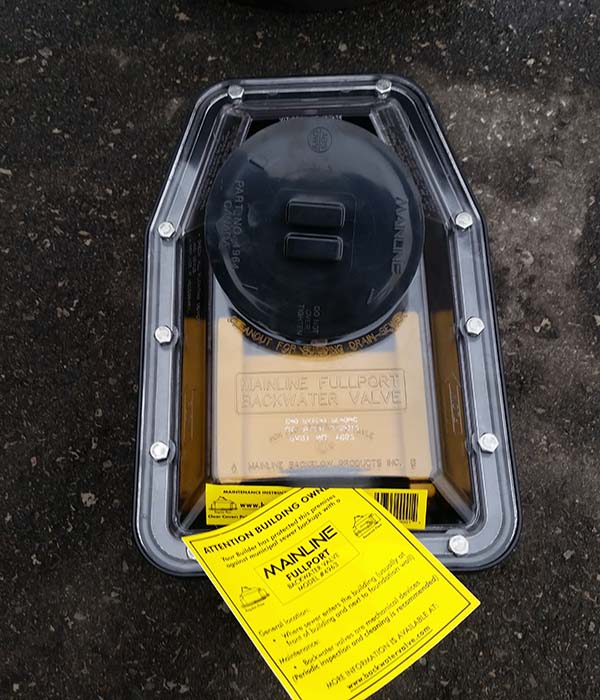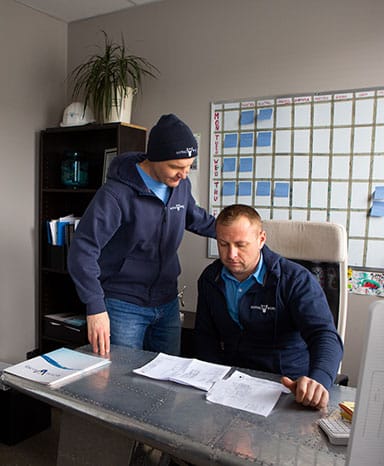

Sewer backups can cause serious damage to your home and belongings. The team at Royal Work is more than willing to help solve your issue.







A backwater valve or backflow preventer is installed below your basement floor on the main lateral drain line to prevent sewage or storm water from backing up in plumbing fixtures or drainage system. It senses a reverse flow and completely closes a gate to stop it from backing up.
Royal Work Corp have over 15 years experience dealing with all manner of basement waterproofing and plumbing issues. It is also known as a backflow valve or sewer backup valve, that can be installed on your sewer line. Its purpose is to restrict water and sewage movement to only one direction, away from your home, and it can go by a number of different names. Sewage and water can pour back into your home if the city’s sewer pipes are overwhelmed by a strong rainstorm. As long as your sewer system is protected by an automatic Back-water valve, the sewer cannot seep back into your home.
Some towns mandate the installation of backflow prevention valve according to backwater valve laws, while others suggest their installation. They can either be installed into a new house from the ground up or they can be added to an existing one. Sewer valve installation during the original construction phase is far less expensive. Ground-level flooding is more likely in homes with basements or where the ground level is less than one foot above street level. The National Plumbing Code requires a backwater valve if any fixtures in a new residence are positioned lower than the street level.
Typical backwater valves are made of 4″ ABS plastic pipe with openings on either end for inlet and outlet of water/waste, a gate with floatation devices on either side, and a clear top with opening for visual inspection.

A backwater valve is the last line of defense from allowing water to enter your home if your sewers are backing up. Every home drainage system is different, so it is important to discuss your plans for changing your current system. Once you’ve decided to proceed with the installation of a backwater valve, our technician will break through the basement concrete floor and dig down to the sewer lateral. This is the pipe that sinks, tubs and toilet wastewater flows through to the sewer. A short piece of lateral is cut out, the backwater valve is then lowered and secured. It will be necessary to disconnect the weeping tile from the sanitary sewer and possibly install a sump pit and pump. New concrete is poured to fill in the basement floor.
The back water valve is designed to close if water ever starts to back up. There are two floatation devices on either side of a gate that will push it closed to prevent sewer water from re-entering the home. When the water pressure is released, the gate will drop back down flat and water will smoothly flow out again. The clear top on the valve allows regular checks to make sure it isn’t clogged. The top should be tightly secured and regular inspection by a plumber is also recommended.
Another area of concern may come from gutter downspouts that are connected to your sewer lateral. Disconnecting and extending them two meters away from the foundation will help prevent excess water from backing up during rainstorms..
Owners can avoid the following basement problems by insuring everything is working correctly. A backwater valves play a crucial role in protecting your basement from flooding..
While there is significant work and expense required to install a backwater valve, the risk of basement flooding and sewer backup will be greatly reduced. The City of Toronto, Halton Region, and Peel Region all offer subsidy programs to help offset the expense.
Below are some details related to eligibility:
The City of Toronto offers homeowners a financial subsidy of up to $3,400 per property to reduce the risk of basement flooding. Owners are required to have a Toronto-licensed plumbing contractor perform an assessment and installation of flood protection devices such as backwater valve, sump pump and pipe severance from the external weeping tile or storm sewer connection.
The Halton Region, including the cities of Burlington, Oakville and Milton, is providing a one-time subsidy to homeowners for flood prevention measures totaling a maximum of $2,725. Reimbursement for materials, labour, permit and taxes for the installation of a backwater valve and disconnecting downspouts and weeping tiles from the sanitary sewer.
The Peel Region, including Mississauga, has a rebate program that provides $700 to homeowners for the installation of a backwater valve and disconnecting weeping tiles and downspouts from the sanitary sewer.
Refer to City websites for application forms and more specific eligibility requirements.
To serve our customers better we have now expanded our services to these areas:
Proper “sewer main” airflow is needed for problem-free drainage throughout the city of Toronto. The installation of an individual backwater valve allows for maintenance of the entire system without disturbing home drainage.Royal Work Corp. is your GTA backwater valve installation experts, providing backwater valve installation services and backwater valve inspection services for the local area. Contact Us today to prevent future basement flooding and help your municipality maintain a healthy drain system.



